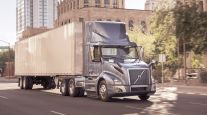Senior Reporter
Class 8 Sales to Rise in 2 Years, ACT Predicts
This story appears in the Dec. 12 print edition of Transport Topics.
Retail sales of U.S. Class 8 vehicles are likely to escalate starting in about two years, according to a leading industry analyst. That’s if the upcoming mandate to electronically monitor drivers’ time spent hauling freight dovetails with an improving economy as well as pro-business and transportation initiatives from the Trump administration.
Class 8 sales were down 21.9% year-over-year through October, the latest month available, according to WardsAuto.com, as publicly traded large fleets sit on the sidelines waiting for the economy to improve.
“If the electronic logging device mandate delivers a fairly large capacity takeout at the same time the Trump administration delivers an infrastructure project, a corporate tax give-back and there are good freight volumes [more machinery being sold], then I think there is a good argument for a run-up in trucker profitability,” said Kenny Vieth, president of ACT Research Co.
As profitability improves, large fleets staring at year-end tax liabilities and the higher cost of operating aging equipment would replace trucks from 2014 and 2015. “And there could be a very nice Class 8 [retail sales] market in 2019 and 2020,” he said.
Vieth made the comments during a Dec. 2 conference call hosted by Michael Baudendistel, a transportation equipment analyst with Stifel, Nicolaus & Co.
About 105,000 more tractors are available now than are needed in the marketplace, he said.
“We think ELD adoption, a positive freight environment and below-replacement Class 8 tractor sales help us get back to close to par by the end of 2017 with supply and demand of tractors and freight,” he said.
The Federal Motor Carrier Safety Administration’s ELD rule takes effect Dec. 17, 2017, and will shift almost all drivers to electronic logging and away from paper reports.
It’s primarily the smaller for-hire fleets that are now cheating in reporting accurately the time spent behind the wheel, Vieth said.
To calculate the mandate’s effects, ACT made some assumptions about these operations’ excess miles, breaking them down by type of service. “If you take those [miles] out, it works out to be a legal impact of about 56,000 tractors’ worth of capacity,” Vieth said.
That’s about 3% to 4% of overall capacity by the time the mandate gets enforced, according to ACT.
“On the for-hire basis, it’s about a 7% takeout of capacity. So this is a pretty meaningful takeout,” he said.
Turning to the economy, he said that freight demand is not as bad as it has been, based on ACT’s “dashboard” of 15 matrices. “It is doing better than the double-digit negatives from earlier in the year.”
Commodity prices also have stabilized and even risen a bit, indicating increased demand, he said.
“So that is a key to the forecast,” Vieth said, adding that if you think about all the suppliers that go into building machines “you are maybe talking six to eight touches by a truck.”
ACT also dropped its earlier expectations of a Class 8 pre-buy ahead of federal greenhouse-gas Phase 2 standards for trucks and trailers.
“We had about a place- holder 20,000-unit pre-buy [in 2020], which, if you pre-buy 20,000 units, you end up with a 40,000-unit decrement in the next year,” Vieth said.
For trailers, the effective date is Jan. 1, 2018. Then in 2021, 2024 and 2027 come more truck and trailer rules. The goal by 2027 is cuts in CO2 output and fuel use of 25% in highway tractors and 24% in vocational vehicles when compared with 2017 vehicles.
What has changed is ACT’s keener understanding of the payback to fleets, Vieth said.
“It is not a one-day, next-day type of event. It is a multiyear type of event,” he said, “and the $8,500 to $9,000 all-in-with-tax cost relative to a 13% improvement in fuel economy, which is advertised, generates a payback of about two years,”
The payback is so good on the aerodynamics and the improvement on parasitic drag that even if the new administration rolls back the Environmental Protection Agency and the National Highway Traffic Safety Administration’s GHG Phase 2 standard, he said, “the vast majority of that mandate is going to happen because the bang for the buck for the fuel economy relative to the cost is so good.”
But if a federal rollback did occur, it could run into tougher standards from the California Air Resources Board that would apply to intra- and interstate trucks operating in the state, which also has the world’s sixth-largest economy.
CARB has been advocating for an ultra-low nitrogen oxide standard, he said. It would slash NOx emissions to 0.02 gram per brake horsepower- hour from the current limit of 0.2 gram, a drop of 90%.
“So it will be interesting to see,” Vieth said.


